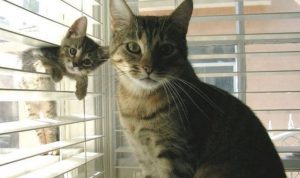I recently teamed two of my favourite things together, science and cats, and made two videos. The first explains some basic genetics using cat coat length as an example:
In the second, I explain some of the genetics of cat coat colour inheritance:
The genetics turned out to be far more complicated than expected but I think it’s super interesting. I now can’t help looking at my cat and thinking, “She’s an agouti cat with the mackerel tabby allele and is homozygous dominant for the piebald gene”. Here’s Marzipan guilt tripping me about leaving her to go to the lab:

I also wanted to talk about cat cloning in my second video but ran out of time. Back in 2001, scientists in Texas successfully cloned the first domestic cat. This was done by a technique called somatic cell nuclear transfer which was also used to clone Dolly the sheep in 1997. They took an oocyte (unfertilised egg cell) from a donor cat, removed the nucleus containing all the genetic material and inserted the nucleus of a skin cell from Rainbow, the cat they wanted to clone. The embryo was then transplanted into a surrogate mother cat. It’s worth noting here that the efficiency of this technique is low, roughly 1%. Of the 87 embryos transferred into 8 surrogates, there were two pregnancies and just one that went to term. On December 22 2001, a healthy kitten named Carbon Copy was delivered by caesarean section. Interestingly, Carbon Copy is not the spitting image Rainbow despite being genetically identical.

“Not Identical Twins...” by Schattenscherbe is licensed under CC BY 2.0
This is likely due to epigenetic reprogramming, how the structure but not the sequence of DNA is changed. This can effect how genes are controlled leading to some being turned on (expressed) and others being turned off (repressed). The epigenetic change happening in these cats is called X-inactivation or lyonization. Just about all female mammals have two X chromosomes and during embryonic development, one copy of the X chromosome in each cell undergoes this process of lyonization. It essentially gets smooshed up into a structure known as a Barr body. This chromosome stays inactive and gets passed onto all its descendants (daughter cells) when it undergoes cell division. As I mentioned in my second video, the gene for orange coat colour is on the x chromosome. Calico cats like Carbon Copy and Rainbow are heterozygous so have one orange and one black allele. Lyonization leads to inactivation of either the orange or black allele in each cell leading to the patches of orange and black on their coats. As this process occurs completely randomly, all calico cats have unique markings. This explains why Rainbow and Carbon Copy have different markings.
